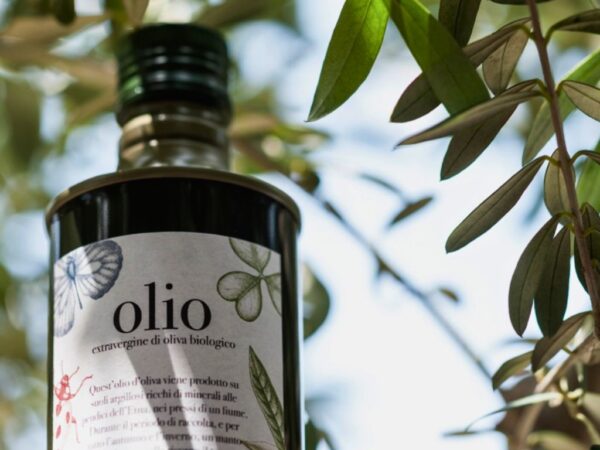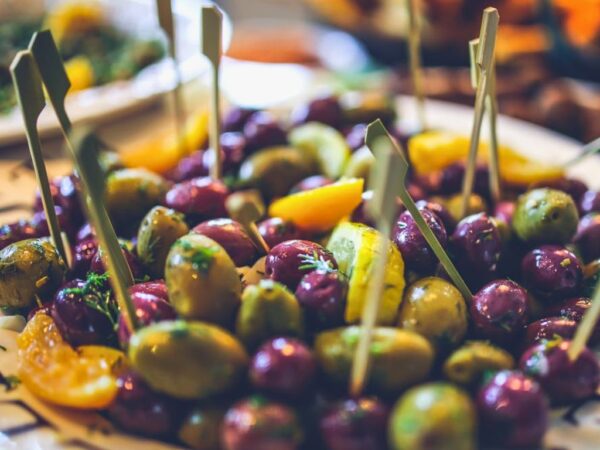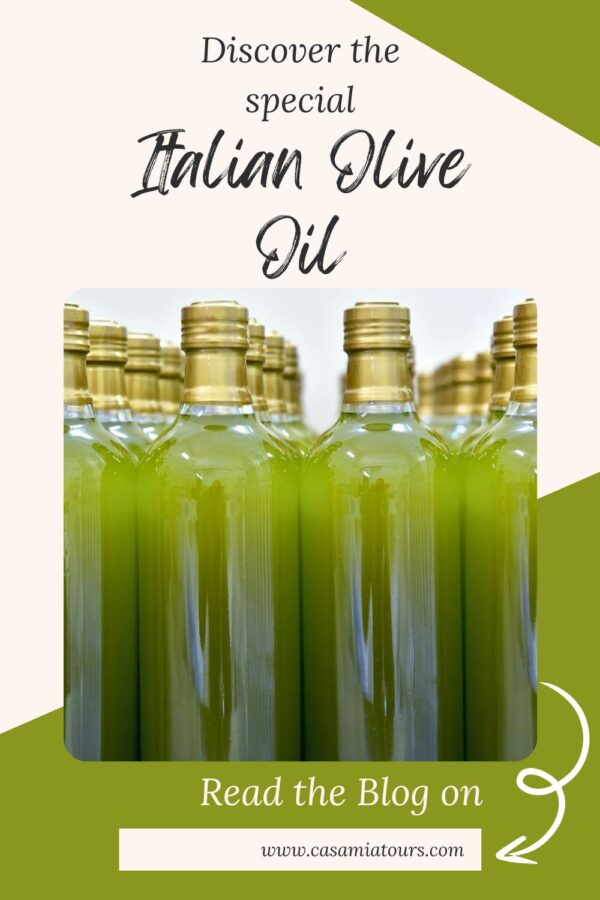Italian olive oil is at the center of all the Casa Mia kitchens. We use it for everything from sauteing soffritto to start a ragù to adding the finishing touch to a tasty soup or salad, as well in cakes, on the grill, for making foccacia and much more. Knowing which type of olive oil to use and understanding the different flavor profiles is essential to any Italian kitchen. Italians are very passionate about their top quality olive oil and have strong opinions on what is and isn’t good oil. Discover why their olive oil is so special with us:

An Introduction to Italian Olive Oil
Olives and their oil have been cultivated in the Mediterranean for thousands of years. Olive oil was an important commodity and was used in all sorts of ways far beyond cooking, such as lamp fuel, soap, cosmetic use and in medicines.
When the ancient Greeks colonized parts of Sicily and southern Italy, one of the things they brought with them were olive trees. The Italian climate and terrain proved to be perfect for the olive trees and they quickly spread all over the south. Olives became a staple food along with the oil and that hasn’t ever really changed!
Today only Spain produces more olive oil, and Italians are also one of the largest consumers. You will see olive trees everywhere in southern Italy and even in some places in the north where the climate is more sheltered, so there is a lot of diversity to explore.
Extra Virgin Olive Oils
When we are talking about Italian olive oil, we really are talking about Italian extra virgin olive oils. Further down we will explain the different terminology when it comes to olive oil, but the main thing to know is that extra virgin olive oils are the highest quality oils available. These are the olive oils that have antioxidant properties that provide a range of health benefits.

It’s rare to find any other type in Italian kitchens. Generally extra virgin olive oils are used here for everything except deep frying, so why would you buy a lower quality version? To demonstrate, on a recent visit to our local grocery store in Rome, they had just 6 types of simple olive oil but more than 30 extra virgin olive oils to choose from. The flavor is just better and there is not a huge price difference either!
Italian Olives
To get Italian olive oil you need olives. While olive trees all look pretty similar, there are actually lots of different varieties. In Italy there are over 400 different types of olive varieties, and just like with the huge variety of native grapes for wine, the terroir and climate play a role in the final products. Even though Italy does not produce the biggest volume of olive oil, it does have the highest number of olive varieties anywhere in the world.
Eating Olives
While olives are the fruit of the olive tree, they are not generally ready to eat as soon as they are picked. Even when fully ripe, olives are bitter when unprocessed. Once olives are picked they are cured to soften the bitter flavor, which can be done in a few different ways.
Some varieties are better suited to oil production rather than being prepared for eating. The Frantoio olive, common in Tuscany, has a high oil content so is used almost exclusively for olive oil, whereas the Cerignola from Puglia have an excellent meaty consistency and balanced flavor that make them an ideal table olive. Other varieties such as the Taggiasca from Liguria, the Nocellara from Sicily and the Gaeta olives from southern Lazio are used to make excellent olive oil and table olives.

Harvest Season
Did you know that green and black olives are exactly the same fruit? Green olives are picked early in the harvest season, when they are full size but haven’t yet started changing color which indicates ripeness. When olives are fully ripe, they will be black (or a shade of purple or brown depending on the type), but the actual variety is exactly the same. The flavor of the olive is slightly different depending on the ripeness, so some are better at the green stage and others when black.
Olive harvest season is quite a prolonged process therefore. The green olives are harvested at the start of the season, around September or October depending on where in Italy you are. For olive oil, the olives need to be harvested just as they have become ripe and are changing color, around a month or so later. Then, if you want black olives, these take a little while longer so it’s common to see the final harvests being done into November or December.
Italian Olive Oil Regions
Because different parts of Italy have their own unique climates and soil conditions, knowing where your Italian olive oil is produced helps you understand the flavor you’re getting. You’d be surprised how different olive oil from Sicily tastes compared to oils from Tuscany! While you will find excellent olive oils from most regions in Italy, particularly Campania, Calabria and the slopes around Lake Garda, here’s what to expect from the main oil producing regions:
Puglia
Puglia stretches out along the eastern coastline in the far south of Italy, and the warmer, drier climate is perfect for growing olives. Olive trees are everywhere in Puglia and the region produces the highest volume of olive oil in the country.

High volume doesn’t mean low quality; the centuries of experience local farmers have means Puglian olive oil is excellent. The native olive varieties create oils that are well balanced and fruity, that work well with almost any dish. Paired with grilled fish or the best summer tomatoes, Puglian olive oil adds tons of flavor without acidity so we find it really moreish!
Some specific PDO/DOP areas in Puglia (protected areas of designation) to look out for are Terra di Bari, Dauno and Colline di Brindisi.
Liguria
Liguria is not a region people instantly think of when it comes to olive growing areas, but trust us, some of the highest olive oil quality can be found here. The Taggiasca olives that grow here are one of the most versatile, producing fantastic table olives (definitely one of our go-to aperitivo olives) and equally fantastic oil.
The extra virgin olive oils from Liguria are lighter and slightly sweeter. They pair amazingly well with the fragrant herbs that grow here – there is a reason pesto Genovese is such a special creation when made with the local basil and olive oil!
The Riviera Ligure PDO is outstanding, made from hand-harvested taggiasca olives to ensure that only the perfectly ripe ones get used for their oil.
Sicily
We make no secret of how much we love Sicily and Sicilian food. From the special Bronte pistachios to delicious street food and wonderful desserts, Sicily is a true foodies paradise. Is it any wonder that we think their olive oil is equally great?!
There is a mix of olive varieties grown in Sicily, from those grown on the slopes of Mount Etna to the valleys around the coastal city of Trapani, so the olive oils produced here are not uniform. However what does characterize Sicilian olive oils is a fruity, almost spicy flavor with herbal notes. For us, there is nothing better than a generous drizzle of Sicilian oil on grilled bread or to dress a fennel and orange salad.
The oils that fall under the Monti Iblei PDO, made from the Tonda Iblea olives, are our top choice. Herbal but not bitter, delicate but full flavored, these olive oils are absolutely delicious. If you’re in Sicily, we can even take you to one of these olive groves and show you how special the olives and oil are!

Tuscany
Tuscan olive oil is an extremely popular choice, for good reason. Made primarily with the local olive varieties of Moraiolo and Frantoio, the final result is far more bold and peppery than the other oils we’ve talked about here.
This means the oils from Tuscany are perfectly suited to the richer, more meat-heavy Tuscan cuisine. The classic Florentine steak would not be complete without being dressed in a good olive oil before serving and Ribollita, a hearty soup made with vegetables, is always finished with a large drizzle of oil.
Despite having a much smaller yield than other regions, there are multiple PDO areas in Tuscany. Some of the best to look for are Terra di Siena and Chianti Classico – the same area that the famous Tuscan wine comes from.

How to Identify Top-Quality Italian Olive Oil
Now that you know the regions and olive varieties to look out for, how else can you decide whether a bottle you are looking at is going to be worth purchasing or not? There are a few things to look out for on labels which will generally indicate good quality olive oils:
PDO/DOP and IGP
These categories, while both indicating quality, are slightly different. PDO/DOP stands for Protected Designation of Origin whereas IGP stands for Protected Geographical Indication. Both are EU categories that are designed to preserve regional production methods and ingredients, and prevent inauthentic products from being sold under false pretenses.
Of the two, PDO/DOP is the stricter category. Every step of the production must have taken place in the designated area, so for olive oil this means the olives have to been grown there, harvested and processed there. IGP is less strict, so you could have oil being processed elsewhere or the olives being supplemented by olives from outside the region.
This does not mean that IGP olive oils will be bad, but we prefer PDO/DOP.
Other Label Information
We would almost always choose from the extra virgin olive oils available. If you see labels that call it pure olive oil or light olive oil, these will not be extra virgin as they will have been subject to additional processing of some kind. Extra virgin olive oils are cold pressed/cold extracted (so they have not been heated while being processed) and cannot be altered in any way. This includes the addition of flavorings, so you cannot have garlic or chill extra virgin oil for example.
Look for information about where the olives came from. If you want Italian oil, look for 100% Italian olives – cheaper oil tends to come from a mix of olives from all over the EU. Even better is if the label says which region or even which farm the olives are from! Simply having “Product of Italy” on the label sadly does not mean the oil is actually from here so it’s important to check the details.
The other important thing to look for is the harvest date, or best before date. Olive oils do not do well with age so you want to enjoy them within about a year to 18 months after the olives are harvested. If the dates are odd, or are not on the label at all, this is an indication that it may not be the best quality.

Learn More About Italian Olive Oil With Us
Just like Italian wine, Italian olive oil is full of variety. It is one of the crucial parts of Italian cuisine so we always encourage our guests to learn more about it while they are visiting, and how much better it makes so many dishes. If you would like to get to know what’s involved on a deeper level, come with us as we visit a Sicilian olive grove filled with trees that are hundreds of years old for a truly special experience. Click here to find out more or talk to us to arrange your own olive oil tasting.









